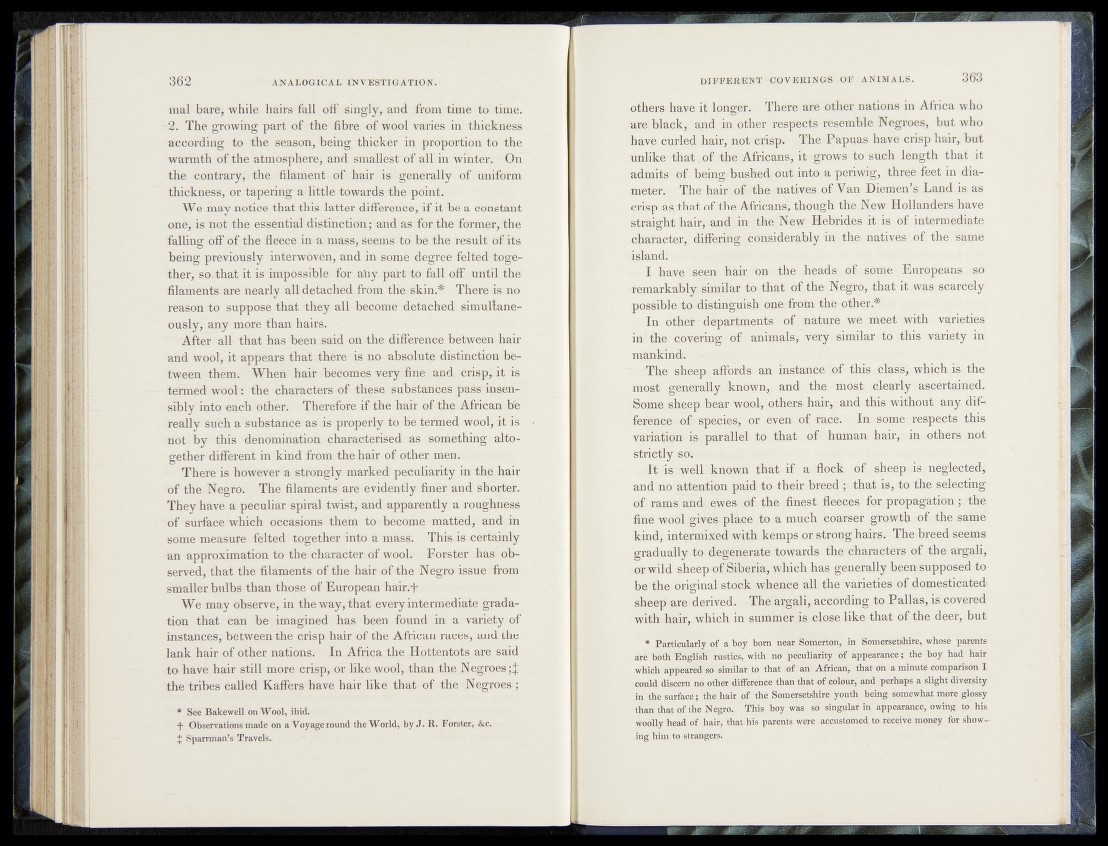
mal bare, while hairs fall oft singly, and from time to time.
-2. The growing part of the fibre o f wool varies in thiekness
according to the seasoft, being thicker in proportion to the
warmth of the atmosphere, and smallest of all in winter. On
the contrary, the; filament of hair is generally of uniform
thickness, or tapering a-little towards the point.
We may notice that this latter difference, if it be a constant
one, is not the essential distinction; and as for the former, the
falling off of the fleece in a mass, seems-to be the result of its
being previously interwoven, and in some degree felted together,
so- that it'is impossible for ahy part to fall off. until the'
filamente are nearly all detached from the skin.# There is-no
reason to suppose that they all become detached, simultaneously,
any more than hairs. |
“After nil that has been said on the difference, betweendiair
and wool, it appears that there is no absolute distinction between
them. When hair becomes very fine and crisp,„it iS
termed wool: the characters of these substances;pass/insen-'
sibly into each other. Therefore if the-hair of the African hfe
really such a substance as is properly to be termed wooly it is
not by this denomination characterised as something, altogether
different in kind from the hair of other men.
There is however a strongly marked peculiarity in the hair
of the Negro. The filaments are evidently finer and shorter.
They have a peculiar spiral twist, and apparently a roughness
of surface which occasions them to becojne matted, „ and in
some measure felted together into a mass. Thisris certainly
an approximation to the character of wool. Forster haü ob-
served, that the filaments of the hair of the Negro issue from
smaller bulbs than those of European haiivt-
We may observe, in the way, that- every intermediate gradation
that can be imagined has been found in a variety of
instances, between the crisp hair of the African races, and the
lank hair of other nations. In Africa the Hottentots are said
to have hair still more crisp, or like wool, than the Negroes
the tribes called Kaffers have hair like that of the Negroes ;
* See Bakewell on Wool, ibid.
-J- Observations made on a Voyage round the World, by J . R. Forster, &c.
J Sparrman’s Travels.
others have it longer. There are other nations in Africa who
are black*.and in other >respects resemble Negroes, but who
have curled hair, not crisp. The Papuas have crisp hair, but
unlike that ;,@£rihe, Africans, it grows to such length that it
admits of being*bushed out into a periwig,; three feet in diameter;
The: hair of. the natives of Van Diemen’s Land is as
crisp_as. that of the Africans^ though the',New Hollanders have
straight hair, and in-/the, New Hebrides it is of intermediate
character, differing considerably in the natives of the same
I have .seen hair on the beads*pf some Europeans so
remarkably, similar to that of the^jegso», that it was scarcely
possible*i<3‘distinguish one.from the other.*
In other departments of nature we meet; with varieties
in 'th e covering of animals, very - similar tq ; this variety in
mankind.
- The sheep- affords an instance )of- this class,' which is the
most generally/known,, and the mosL clearly ascertained.
Some she.epi b.ear wool, others hair, and this without -; any dift
ference of j-species; or even of race. In -some respects- .this
variation is -parallel to that .off- human hair, in others not
strictly
It is well, known that if a flock of sheep.-is neglected,
and:no attention paid to their breed ; that is, to the selecting
of rams and ewes of the finest fleeces for propagation; the
fine wool {gives place to a much jco a lrse r growth of the same
kind, intermixed with kemps or ttrong.hairs. The breed seems
gradually to degenerate towards theriharricters of the argali,
or wild sheep p f Siberia, which has generally been supposed to
be the originahstock whence ail the varieties of domesticated
sheep are derived^ The argali,1 according to Pallas, is covered
with hair, which in summer is close like that of the deer, but
* Particularly of a boy born near Somerton, in Somersetshire, whose parents
are both English' fritics, with no peculiarity of appearance; the boy had hair
which appeared so similar to1 that -of an - African, that on - a minute' comparison I
could discern no other difference than that of colour,’ and perhaps a slight diversity
in the surface; the hair of the Somersetshire.yputh being somewhat more glossy
than that of the Negro. This hoy was , so singular in appearance, owing to his
woolly head of hair, that/his parents were accustomed to receive money for showing
him to strangers.